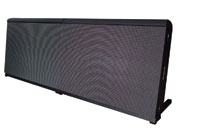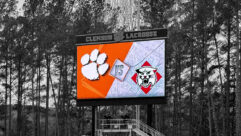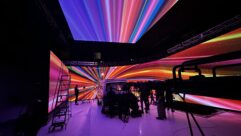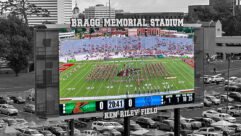

Sports Venue LED Displays Technology Showcase
Jan 5, 2011 12:00 PM,
By Bennett Liles
Akira Digital Signage Neoart LED series
The march of video technology has rarely been as public and spectacular as in the realm of large LED displays for sports venues where digital signage is hyped with live video and game replays. The progression from incandescent light rows for scoreboard numbers to crawling text to HD video on LED boards has seen increasingly capable display elements and vastly more sophisticated control systems. These displays have become the technical and visual centerpiece of their respective venues.
Related Links

LCD Display Monitors Technology Showcase
As many have learned over the past few years, there is a good bit more to building an effective digital signage network, control room monitoring system, or a knockout videowall than just connecting a few wires and bolts and making things flash….

Digital Signage Technology Showcase
Not very long ago, billboards, posters, fliers, and banners were relied upon heavily to capture people’s attention and direct their focus to the company or product being depicted….

When it comes to digital signage in corporate environments, it’s important for the system integrator to realize that many different departments within an organization will all want to contribute to, or perhaps control, the messaging. …
The high-profile events in which they are used and the financial investment required have combined to usher in a new level of reliability and service friendly design with modular construction and rugged wiring connections behind the scenes to ensure maximum performance at game time. Recent years have seen a dramatic rise in screen resolution, widening angles of view, smoother motion, expansion of color palette, and some bombastic examples of sheer size.
On the boards, or the modules of which they are composed, there are either discrete LED lamps in a lamp-based design or a surface-mount device (SMD) style that uses lenses for all the lamps in each pixel and allows a greater angle of view without a color distortion known as shouldering. This is where individual LEDs begin blocking each other and altering the colors as the viewing angle becomes extreme. With SMD displays, the angle can extend up to 160 degrees. SMD boards can also provide a smaller LED pitch with 3mm to 9mm between individual display elements. The smaller the pitch, the shorter the minimum viewing distance—as short as 10ft. from a 3mm board and between 150ft. and 300ft. from a 20mm board. Cutting the pitch in half increases the number of display elements four times for a board of specific size.
LED displays may use either static drive or scan drive. In a static-drive unit, all the LEDs in the display light up simultaneously to show the image. In a scan drive product, the LEDs are illuminated one line at a time within a certain group of lines. A scan drive is similar to the way an image is painted, line by line, onto a CRT screen. Scan drives are used on smaller-pixel-pitch displays to reduce the number of IC drivers used on the display, thereby saving money and space on the PC board. Scan drive requires higher currents and limits the brightness of LED displays. Consequently, it is used only on smaller-pixel-pitch displays, typically indoor types, because of their lower brightness requirements. Exterior models with larger pixel pitch usually require static drive to achieve the brightness levels needed for outdoor viewing.
Advances in design have included a black matte finish and small continuous or segmented louvers over the elements to mitigate the effect of ambient light on display contrast. The size of some of the more recently installed units has required the display company to assume to some degree the roles of architect and construction foreman to meld the aesthetic and structural aspects of the product with those of its new home. The unit’s International Protection (IP) rating refers to its ability to seal out dust and other particles (first IP digit 0-6) and water (second IP digit 0-8) and a third digit can indicate impact protection. Among outdoor displays for sports venues, the IP rating, such as IP65, is a significant factor considering the investment and expected lifetime of the products.
Typical of the outdoor LED display modules from Akira Digital Signage is the Neoart LED series including the DL18.75 featuring discrete LEDs in a 1R, 1B, 1G pattern with an 18.75mm pitch and 2844 pixels per square meter. Each unit is 23.6″x11.8″ and provides a brightness of 6500 nits (candelas per square meter) and a contrast ratio of 900:1. Units with 7000 and 8000 nits are also available. The display allows a horizontal viewing angle of 140 degrees and a vertical angle of 100 degrees while producing 14-bit color with a color depth of 16,384 steps at a 400Hz refresh rate. Higher refresh rates are available. The modules mount from the front using guide pins for proper alignment and an adjustable T-bar arrangement allows mounting in curved frames. The modules may also be daisy-chained in single file for strip LED displays with each DL18.75 using a maximum 200W. The rear structure has die-cast aluminum cooling fans and is reinforced to prevent bending. The internal fans have an autoprotection sensor, and the unit features autodetection of switch-mode power supply (SMPS) activity and data transmission error.
Sports Venue LED Displays Technology Showcase
Jan 5, 2011 12:00 PM,
By Bennett Liles
Designed to provide high-quality video images in an outdoor, high-ambient-light environment, the TF-16BK module from Barco uses a flat black matrix background for high-contrast output and 16mm pixel pitch to deliver fine detail with a three-black-lamp LED configuration. Each tile is 60″x60″ with a density of 3600 LEDs, producing a typical calibrated brightness of 6000 nits and a contrast ratio of 7000:1. The unit has 16-bit color processing and a 110-degree horizontal viewing angle to 50 percent brightness. It also features an 800Hz refresh rate and maximum power consumption of 400W with an average consumption of 120W. The tile is 37.8in. square, weighs 106lbs., and has a rated operating life of 100,000 hours. This is a vital specification on such equipment due to the high ticket investment made in these display systems. Each TF-16 tile is rain-rated (IP65 front, IP54 back) with clickable shaders, and each has an operating range spec of -31 degrees to 122 degrees Fahrenheit with a choice for maintenance access from the front or rear. The tiles can be mounted in flat, convex, or concave shaped frames to suit existing architecture.

D3 LED TrueElement
For a small-footprint, lightweight-module design, D3 LED (Dynamic Digital Displays) offers the TrueElement Gigabit Ethernet-based outdoor LED display module with 16-bit color processing, diagnostic features, and diode level color calibration provided by its Windows-based control system. Each 14.9in.-square tile weighs less than 20lbs. and is weather-sealed by two vacuum-molded rear cover panels. Each unit has its own temperature-sensing, forced-air cooling with auto-high-temp shutoff, a data distribution system, and onboard memory. When one module is substituted for another, the replacement automatically imports its address and calibration data from those around it through the bottom-mounted RJ-45 port. Each module is installed into a steel frame by way of a spring-loaded four-point latching system with adjustment pins, allowing access from front or rear using no special tools. The TrueElement Smart Module is designed with a recessed area on the bottom that includes connection ports for power, data, and ventilator. Pixel pitch availability ranges from 8mm to 24mm, and the TrueElement Front End Video System accepts high-def signals including uncompressed HD-SDI, HDMI, and Blu-ray.

Daktronics DVX series
Daktronics fields a wide variety of LED signage products including indoor/outdoor tile modules and ribbon board displays. Among the outdoor LED display modules offered is the DVX line with sealed inputs and outputs along with a louvered face to increase contrast in high ambient light and mask the seams between panels. The DVX products range in pixel pitch from 10mm, with a minimum viewing distance of 22ft., to the 26mm module, with a minimum viewing distance of 59ft. The smaller 10mm and 12mm resolution modules use three-in-one SMD pixels providing a viewing angle of 140 degrees horizontal and 75 degrees vertical. The larger-pitch modules use discrete red, green, and blue LEDs. The modules use adaptive cabinet mounting for a range of available display shapes and allow LED-level (sub-pixel) processing for smooth motion and sharp lines. The displays are rated at 100,000 hours, and system health monitoring is done through Intelligent Device Management (IDM). The Venus 7000 display controller can be used for video, fascia, and message center displays, and with its Quick Display feature, it can launch synchronized presentations with background audio. A calibration feature allows newer, brighter LED modules to be matched to older ones to avoid a patchwork appearance.

Lighthouse Jumbovision Pi6-S and Pi10-FA
One of the newest and most advanced integrated LED video displays has been provided by Lighthouse Jumbovision for the Bradley Center, home of the NBA’s Milwaukee Bucks. Designed by Anthony James Partners and integrated by TS Sports, the Bradley Center’s new center-hung video board features more than 1,000 square feet of Lighthouse Pi6-S 6mm-pitch LED video distributed across four main screens, plus 300 linear feet of Lighthouse Pi10-FA 10mm-pitch entertainment strips encircling both the top and bottom of the center-hung videoboard. In addition to a scoring matrix and four LED video corner wedges that feature the home team’s logo, the center-hung videoboard boasts a world’s first underside LED video display featuring a Lighthouse P16i/o (16mm) screen, which is capable of displaying video, logos, and animations. The Bradley Center’s one-of-a-kind center-hung video display features more than 2,500 square feet and nearly 3.5 million pixels of LED video. The new video system is 29ft. tall and 32 ft. wide, and it weighs approximately 50,000lbs. One of the most beneficial aspects of the all-LED video system is its versatility. In addition to the Bucks, the Bradley Center hosts Milwaukee Admirals hockey, Marquette University basketball, and Milwaukee Iron arena football. The new scoreboard can be customized to provide a true home court or field for each team.
Sports Venue LED Displays Technology Showcase
Jan 5, 2011 12:00 PM,
By Bennett Liles
Using an automated vision calibration process, Mitsubishi Electric adjusts the brightness tolerance of each LED on the Diamond Vision display modules to match brightness across the entire display. The face of each unit uses a pixel-placement-and-louver combination to eliminate color shift and maintain contrast in high-ambient-light conditions. Three display controllers are available, the most advanced of which provides simultaneous presentation of live video, data, messaging, animation, and graphics on any part of the screen. The most spectacular example of Mitsubishi’s Diamond Vision is the 544-ton center-hung screen in the Dallas Cowboys Stadium, where each sideline display—composed of AVL-ODQ10 modules—is nearly 11,500 square feet and contains more than 2.5 million LEDs. The two smaller end-zone screens are nearly 1500 square feet. The Diamond Vision LEDs are arranged so that each pixel has one green, one blue, and two red lights, while the processing allows sharing of LEDs between adjacent pixels to create dynamic pixels. In total, the Cowboys Stadium screen has 30 million LEDs for showing 1080p video signals using a pitch of 20mm on the side screens and 16mm on the end displays, consuming a total of 1430kW.

NEC Display Solutions LED-15BF1
The LED-15BF1 large screen “true pixel” LED panel from NEC Display Solutions has discrete red, blue, and green LEDs in a through-hole design using 15.625mm pitch with 64-level dimming capability and 14/16-bit color processing for a maximum of 7500 cd/m² brightness and 4500:1 contrast ratio. The viewing angle to half brightness is 70 degrees to either side, 15 degrees up and 30 degrees down from center. The weight of each module is 31lbs., and maximum power consumption at full white is 135W. Using long-life Nichia LED lamps for accurate color matching between modules, the IP65-rated unit has an expected lifetime of more than 100,000 hours and uses a DVI-D dual-link connection for video and control. The low-latency video processing with 800Hz refresh rate features tearless frame-rate conversion for connection of any source to any display. The control software provides automapping of pixel allocation and auto locating in the videowall to ensure each module gets the correct portion of the overall display image. Each module offers both front and rear service ports to accommodate any installation structure.
For outdoor, fixed installation with IP65/IP43 front/rear ingress protection, the VL-12 in Toshiba’s Vista-Light series is a 12mm LED screen module producing 6000 nits brightness and a viewing angle of 160 degrees horizontal and 60 degrees vertical. Using discrete Nichia LEDs in a 1R, 1B, 1G oval pattern, the unit has an average power consumption of 240W and 685W maximum. The VL-12 unit is 31.5in. high, 47.24in. wide, and 5.51in. deep with an operating temperature range from –4 degrees to 122 degrees Fahrenheit. It weighs 158lbs., and it can be assembled into videowall displays from 56.78in. to 1574.8in. diagonal. With 16-bit processing and a 1440Hz refresh rate, the unit provides a physical resolution of 1600 pixels per square meter, and with its virtual pixel sharing technology, it yields an effective resolution of 6400 pixels per square meter. The Vista-Light series modules are available in indoor/outdoor configurations from 6mm to 15mm in pixel pitch.

Trans-Lux TL Vision
The 20mm TL Vision TL-OV20 from Trans-Lux uses a static-scanned 2R/1G/1B pixel arrangement with IP65/IP43 front/rear ingress protection and produces a brightness of 6000 nits with 16-bit processing and a contrast ratio of 1500:1. The unit provides a viewing angle of 140 degrees horizontal and 70 degrees vertical with a pixel density of 2500 per square meter and a 1000Hz refresh rate. The display offers levels of manual dimming and 16 automatic levels while consuming 684W per square meter maximum and 227W per square meter on average. Pixel sharing produces a virtual pixel pitch of 10mm, and the modules can be cabinet mounted in a number of configurations and allow front or rear service access.








